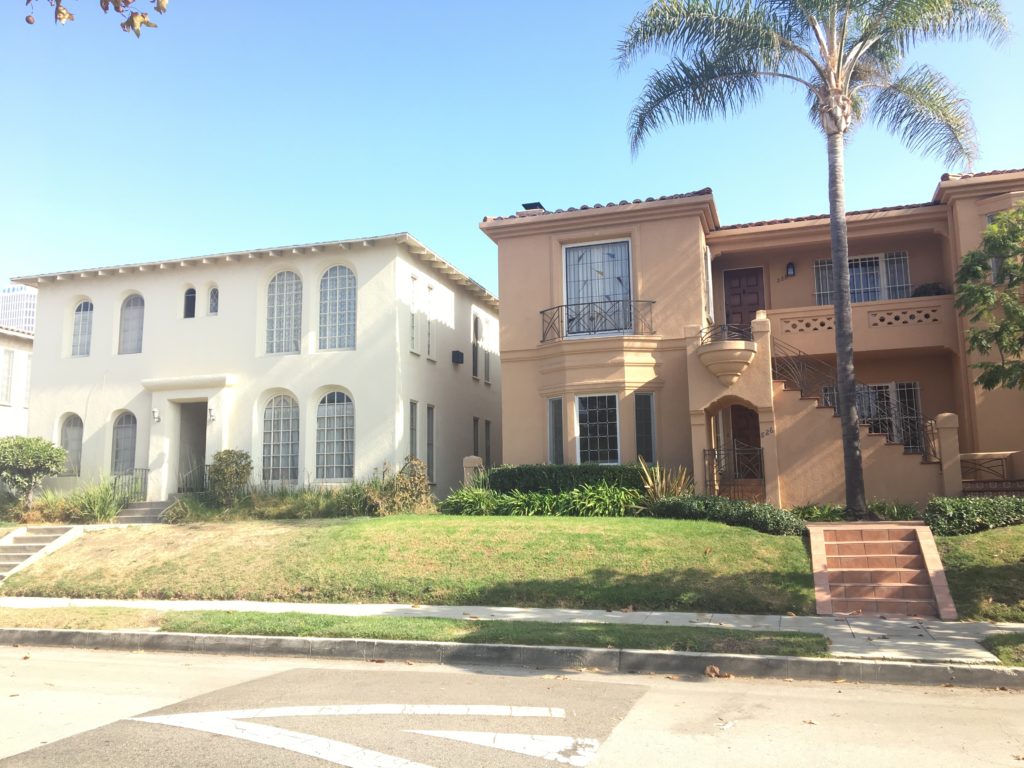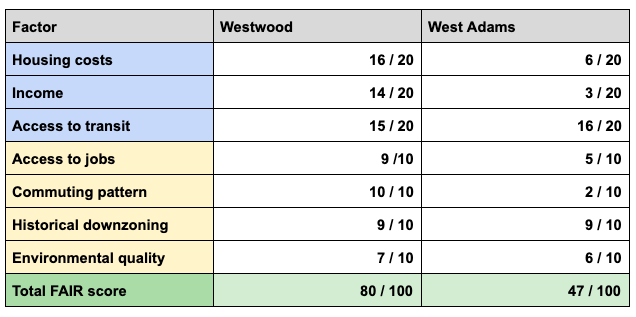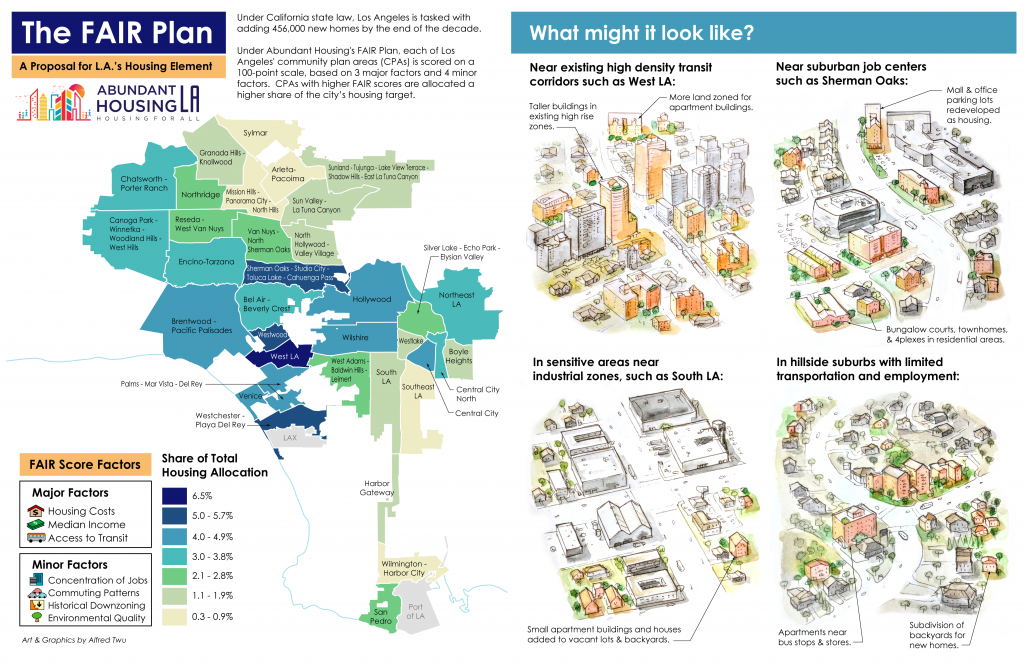
Get ready: by the end of the decade, Los Angeles might build over 450,000 new homes.
This might surprise many readers. Have YIMBYs hypnotized the L.A. City Council? Not quite. Every eight years, cities are required under state law to update their housing elements, a planning document that assesses a city’s housing needs and sets a strategy for accommodating new housing at all income levels.
Historically, many cities found ways to avoid creating housing elements that would actually lead to more homebuilding. But ahead of this housing element cycle, which starts in 2021, new laws were passed to beef up compliance and enforcement.
Thanks to your advocacy, the state gave Southern California a historically high goal of over 1.3 million homes, and local officials allocated most of that target to coastal cities with good access to jobs and transit. In particular, Los Angeles was assigned a target of 456,000 new homes, which, if achieved, would increase the housing supply by 30%.
Now, cities across Southern California are beginning work on their housing elements. Abundant Housing is proud to be serving on L.A.’s housing element task force, alongside more than 60 other community stakeholders.
We’re committed to supporting a housing element plan that equitably achieves L.A.’s housing production target. A few months ago, we shared policy ideas for the housing element that we think will improve affordability, environmental quality, and transit access throughout L.A.
One of the first steps towards that goal will be deciding how to allocate housing targets across L.A.’s neighborhoods. Abundant Housing recommends allocating most of the housing target to wealthy, high-opportunity neighborhoods, and to neighborhoods with good access to transit and jobs. We support this approach because:
- Many high-opportunity neighborhoods have historically avoided adding new housing through exclusionary zoning. This drives up the cost of housing in these areas, and limits them to residents with high incomes. Ending exclusionary zoning by adding housing in high-opportunity neighborhoods will reduce income and racial segregation, provide residents with more housing options, and reduce displacement as expensive areas satisfy more of the city’s total demand for housing.
- Adding housing in highly desirable neighborhoods will lower rents throughout Los Angeles. This means that residents will have more disposable income, which is good for Los Angeles’ small businesses and the local economy.
- More homes near jobs and transit means that more Angelenos can get to work without driving long distances. This means greater economic opportunity, shorter commutes, less traffic, and lower carbon emissions.
- Denser infill housing near jobs and transit also shifts development away from environmentally-sensitive areas, which helps preserve green space.
This is why Abundant Housing, together with our friend Dario Alvarez and his colleagues at Pacific Urbanism, have created the FAIR Plan.

Under this methodology, each of Los Angeles’ community plan areas (CPAs) is scored on a 100-point scale, based on 3 major factors and 4 minor factors. CPAs with higher FAIR scores are allocated a higher share of the city’s housing target. The dashboard of interactive maps below provides more detail on how each CPA scores under the FAIR Plan (you can also take a closer look here).
The three major factors are housing costs, incomes, and transit access. The four minor factors are jobs access, commute pattern, historical downzoning, and environmental quality. For each factor, CPAs are ranked from highest to lowest, and scored out of 20 points (major factors) or 10 points (minor factors).
- Housing costs are defined as the median home sale price per square foot in a CPA. CPAs with higher home sale prices per square foot are allocated more housing. Putting more homes where housing costs are high is essential for making housing more affordable.
- Income is defined as the median household income in the CPA, and acts as a proxy for overall access to resources. CPAs with higher median incomes are allocated more housing, which will expand access to good schools, services, and economic opportunity.
- Transit access is defined as the proportion of the CPA’s land that is within a Transit-Oriented Communities incentive zone, weighted by tier. CPAs with better access to rail and bus are allocated more housing, which will boost transit ridership and reduce car dependence and GHG emissions.
- Jobs access is defined as the number of jobs in the CPA. CPAs with more jobs are allocated more housing, which will help neighborhoods address their jobs/housing imbalances.
- Commute pattern is defined as the ratio of commuters entering the CPA to commuters leaving the CPA (“in-commuting ratio”). CPAs with high in-commuting ratios are allocated more housing, so that more people can live near their jobs instead of commuting long distances.
- Historical downzoning is defined as the percentage change in zoned capacity between the 1970s and the 2000s. CPAs that changed their zoning to reduce housing capacity and exclude new residents are allocated more housing. This will right a historical wrong.
- Environmental quality is defined as a weighted average of various measures of pollution and environmental risk. CPAs that have high environmental quality are allocated more housing. This will allow more people to live in environmentally healthy areas.
Let’s use Westwood and West Adams as examples of how the FAIR score is computed:

Under the FAIR Plan, the largest housing allocations would go to Westside CPAs, plus the Sherman Oaks, Hollywood, and Center City CPAs. West Los Angeles would be allocated about 30,000 homes, Westwood would be allocated 26,000 homes, and Westchester would be allocated 24,000 homes. In contrast, the FAIR Plan would allocate relatively small housing targets to lower-income CPAs that are far from transit and job centers. Arleta-Pacoima would be allocated 1,300 homes, Wilmington-Harbor City would be allocated 2,600 homes, and Mission Hills would be allocated 3,800 homes.
Additionally, the FAIR Plan also includes CPA-level housing growth targets by income level. Los Angeles’ target of 184,000 homes that are affordable to lower-income households must be distributed fairly across CPAs. High-income, exclusionary neighborhoods should not be allowed to shirk their duty to accommodate affordable housing, while lower-income, disadvantaged neighborhoods also need significant amounts of new affordable housing to address existing need.
To achieve these goals, the FAIR Plan allocates affordable housing across CPAs based on median income and patterns of segregation. In historically disadvantaged CPAs, a higher percentage share of the total housing growth target would be affordable housing. But higher-income CPAs with a history of exclusion would receive the largest number of affordable homes (since they have the highest total FAIR Plan targets overall).
To offer an example: under the FAIR Plan, 36% of Westlake’s housing growth target would be affordable to households with very low incomes. For high-income Westwood, 22% of the total housing growth target would be affordable to households with very low incomes. But since Westwood’s total housing growth target (26,000 homes) is much higher than Westlake’s (8,300 homes), the FAIR Plan would yield more new affordable units in Westwood (9,000 homes) than in Westlake (5,200 homes). At the same time, a higher share of Westlake’s total housing target would be affordable to lower-income households.

Overall, 65% of the RHNA allocation would be distributed to CPAs on the Westside and in the Valley. South LA and the Eastside would receive just 14% of the city’s housing target.

Ultimately, Abundant Housing believes that the FAIR Plan furthers the goals of the Housing Element Task Force, and that every resident of Los Angeles will benefit from:
- Lower rents
- Less tenant displacement
- Less income and racial segregation
- A stronger regional economy
- Greater access to jobs, transit, and economic opportunity
- Lower climate emissions and better environmental quality

